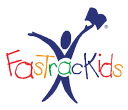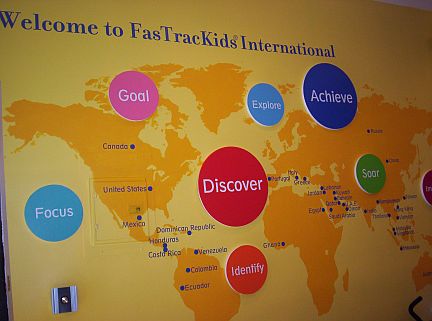FasTracKids Educational Goals
1. To Prepare Children for School and for Life:When today’s children begin to enter the workforce, chances are that they will be working in jobs that have not been created yet. Children will need the ability to think creatively in order to succeed in our rapidly changing world. The FasTracKids® classroom is a child-centered environment, where children are encouraged to be instrumental in their own learning. The incorporation of an interactive whiteboard, part of The FasTrack Learning Station®, allows the children to be directly involved in the early learning concepts that are being studied. Their interaction with this technology gives them confidence at an early age that will be useful later in life, when other technology skills are needed. The CD-Rom based curriculum combines hands-on activities, role plays, experiments and videotaping to develop a fun, interactive lesson. The students will grow in their self confidence and self esteem while they build a solid foundation for future learning. When children begin their learning experience in a fun, high energy environment, their love of learning will carry through the remainder of their educational experiences. 2. To Develop Creative Thinking and Problem Solving:These early childhood lessons promote active and reactive thought processes by engaging children in the exciting subjects of the FasTracKids curriculum. The experiments and hands-on activities make the most of children’s creative problem solving (lateral thinking), critical thinking and expressive processes. Children explore the world of decision-making and build on their entrepreneurial skills. Creativity and originality are stressed through discussions, projects and activities. Children join together to strengthen their ability to work toward a common goal. The FasTracKids curriculum is a balanced early education program that utilizes both hemispheres of the brain. Through experiments, projects and hands-on activities, the children identify and solve problems as they encounter new challenges along the learning continuum. 3. To Build Communication and Speaking Skills:The FasTracKids curriculum teaches how to use extensive discussions and reporting to help children make the most of their communication skills. Through the use of videotaping, the children organize their thoughts and ideas into presentable narratives for their classmates. Children are encouraged to use full sentences and new vocabulary to expand their presentation skills. Using role-play and working in groups, the children practice negotiation skills and join together as a team for the successful execution of early childhood projects. 4. To Teach the Application and Transfer of Knowledge:Children are given the opportunity through hands-on activities and projects to understand the meaning of the acquired information from the FasTracKids lessons. The children learn to classify and categorize the new concepts and experiences into a logical order. They are able to apply this newly found knowledge to challenging everyday situations. A student’s ability to receive information and create a relevant connection to a new situation shows a higher order thought process and assures that the student fully understands concepts that are presented. 5. To Promote Leadership and Personal Growth:Children assume positive leadership roles as they role-play and interact in group situations. They, in turn, develop the ability to follow someone else’s lead and become a functional team member. The teams are responsible for decision-making and follow-through as they complete their goal. The experience of leading a team in early childhood strengthens the self-esteem and confidence of students. The practice of interpersonal skills helps students be internally motivated in setting and attaining personal goals in school and in life. 6. To Encourage a Lifelong Love of Learning:Children love FasTracKids because the programs capture their attention and stimulate their curiosity. They experience the joy of success and strive to reach new education heights. Through actively engaging in the early learning process, they develop an insatiable desire to know more. This desire turns into a passion for learning that ultimately leads to continued success as children become life-long learners.
|

